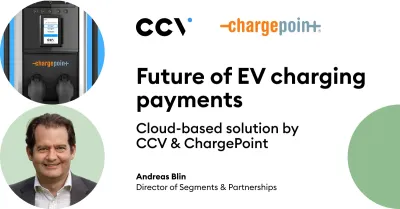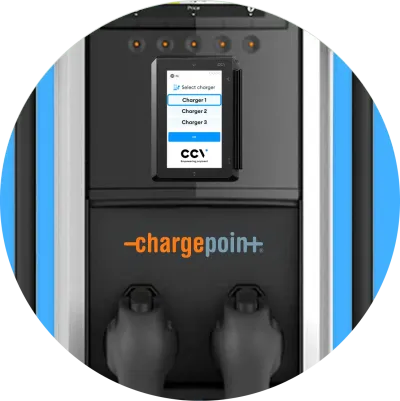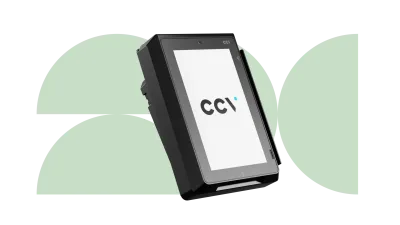Driving innovation together: CCV & ChargePoint

CCV & ChargePoint’s joint approach to cloud-based EV charging payments
A closer look at how CCV and ChargePoint are simplifying EV charging with ad-hoc payments.
In 2024, CCV and ChargePoint joined forces to create a cloud-based payment solution designed to simplify payments in EV charging. At Power2Drive 2025, we spoke with Andreas Blin, Director Segments and Partnerships – CPOs, Fuel & Convenience, and Solution Partners at ChargePoint, about what sparked the collaboration, how the joint solution is being received, and where the EV charging market is heading.
Together, we explored how open standards, multi-port terminals, app-free charging, and simplified integration are driving real impact — showing how strategic partnerships can deliver meaningful value for charging manufacturers and operators.
ChargePoint and CCV have been working closely together on the creation of this simplified payment solution for EV charging. What inspired the development of this joint solution?
Andreas Blin:
ChargePoint’s mission is to make charging as easy as possible and to enable our customers (CPOs & MSPs). For integration of bank-card payments there are several aspects that drive the industry: the first one is government mandates for enabling card-present payments (e.g. EU-AFIR, UK-PCPR). But we believe this should not be the only reason. We perceive it our goal to bring the maximum number of charging sessions to our customer. Ad-Hoc Charging with bankcard is simply another step to increase traffic and utilization.
Two further points are crucial to anything we develop and deploy: First, scalability – anything we touch needs to work without limits, because we see the EV-infrastructure still at the beginning of a massive growth. And second: our be.ENERGISED customers need flexible and future proof solutions that can scale, therefore we are quite stubborn to work only with standard protocols – in this case we connect to the payment service via a cloud-to-cloud OCPI connection. The necessary extension was developed by ChargePoint and entered into the OCPI standard.

Could you tell us more about the cloud-based solution developed with CCV? Which party contributes to which part and how does it stand out in today’s market?
Andreas Blin:
When you look at the challenge at hand without prejudice and with a view to solve the problem, the obvious solution is to connect the professionals in for each of the individual tasks via an OCPI connection – de-facto roaming into the CPO backend from the payment cloud solution. This allows every party to play their strengths while giving freedom of choice to the CPO as the common customer. Everything that has to do with starting and stopping the charging session and producing the necessary CDR as well as creating and providing the required invoice is done by the be.ENERGISED CPMS (Charge Point Management System) – the operations necessary to process the payment are done by CCV. There could not be a cleaner solution.
For the driver it is important that he or she is well guided through the process and can operate the terminal with ease. So, a proven unit such as the IM15 or the IM30 is a logical choice. The fact that the whole charging process can be initiated from the payment terminal screen, as well as the payment process itself is also a huge simplification for end-users.
Could you tell us more about the cloud-based solution developed with CCV? Which party contributes to which part and how does it stand out in today’s market?
Andreas Blin:
When you look at the challenge at hand without prejudice and with a view to solve the problem, the obvious solution is to connect the professionals in for each of the individual tasks via an OCPI connection – de-facto roaming into the CPO backend from the payment cloud solution. This allows every party to play their strengths while giving freedom of choice to the CPO as the common customer. Everything that has to do with starting and stopping the charging session and producing the necessary CDR as well as creating and providing the required invoice is done by the be.ENERGISED CPMS (Charge Point Management System) – the operations necessary to process the payment are done by CCV. There could not be a cleaner solution.
For the driver it is important that he or she is well guided through the process and can operate the terminal with ease. So, a proven unit such as the IM15 or the IM30 is a logical choice. The fact that the whole charging process can be initiated from the payment terminal screen, as well as the payment process itself is also a huge simplification for end-users.

You mentioned CCV’s IM30 payment terminal – what makes this solution particularly valuable for EV charging operators and their customers?
Andreas Blin:
Reliability and durability are key elements – Charging stations are not supervised and are out in the open. Additionally, it is important to give the driver clear instructions, so the screen and the readability of the screen in all lights conditions is key. Also, the IM30 is a well-established unit, hardware manufacturers and installers know how to integrate it into stations, and it uses a standardised cut-out (EVA).
Another important feature of the IM30 in combination with be.ENERGISED is the possibility to serve multiple charging ports and stations through one single terminal, allowing CPOs to optimise not only cost but also operations and convenience. Guiding the customer through the menu and clearly showing the choice of ports on the large IM30 screen makes Ad-Hoc charging very easy. The possibility to enter a PIN, if necessary, via the screen is another important asset – and finally the fact that the IM30 is equipped to read magnet stripe or the chip ensure that every card can be processed.
How have the first ChargePoint Operators responded to the Cloud-Connect solution so far?
Andreas Blin:
Very, very positive! In the last years the situation for CPOs was very uncomfortable as they had to endure endless discussions about payment topics and integration options – all of which are not in their scope, as our CPO customers want to install and run charging infrastructure. With this OCPI based solution there is clarity regarding the responsibilities and integrations. Furthermore, while we have always seen a low adoption of Ad-Hoc payments via online payments (e.g. QR code payment), the sites that are equipped with a functional CCV terminal see a significantly higher number of Ad-Hoc sessions.
What makes this partnership between ChargePoint and CCV unique in the EV Charging landscape?
Andreas Blin:
Usually, when two leaders in their field join forces the results are outstanding – this happened here too. As mentioned before: I don’t like to pretend that we are going through this effort only to comply with AFIR regulations. ChargePoint’s job is to support e-mobility the best we can by providing the solutions to charge – CCV’s task is to provide the smoothest payment regardless of the sold commodity. It is a logical partnership and very much appreciated by our customers.
Also: the scale of the partnership, once we start to roll this out on a larger scale, it will surprise the market as well as ourselves.
We are here at Power2Drive 2025 – what standout trends are you seeing this year?
Andreas Blin:
EV Charging has become an industry – we see focus, consolidation and clarity in roles. The players who did not find or cannot find their space in this ecosystem will have a hard time surviving. As ChargePoint, we have a razor-sharp focus on our business case and – even more important – the business cases of our customers.
On the hardware side, trends at Power2Drive are of course Mega-Watt Charging for Trucks. On the software side we find more and more customers are rethinking their strategy to develop and maintain their own back-end solutions. If you look at the amount of ports and stations an individual CPO needs to manage, and if you are brutally honest that the OCPP and OCPI part of it does not differentiate you in the view of the consumer, then it becomes very obvious that resources at CPOs can be allocated better than to code lines of OCPP and basically copy what is already available in the market.
How do these trends align with CCV’s and ChargePoint’s shared vision for EV charging payments?
Andreas Blin:
If the driver requests a solution for debit/credit card payments, and the EU mandates it, the CPO must provide it. In the past everybody scrambled to get the different streams connected and accepted workarounds and proprietary interfaces, APIs and protocols. But everybody must admit that these solutions are not scalable. Therefore, CCV’s and ChargePoint’s strategy of connecting via a standard protocol – which was designed to exchange precisely the data and commands necessary to solve the issue at hand obviously aligns with the trends.
Additionally, CPOs see the need to streamline their operations, and this requires them to manage as many assets as possible in as few systems as possible. In a rapidly growing environment mistakes can become very expensive very quickly. And I am not only talking about fraud, which always presents risks, but also about wrong or inconsistent pricing – this can lead to complaints, crediting and escalation of overhead costs. Frankly, this is not such a high margin business, so we need to continuously find efficiency to make this transition succeed.
Andreas, what are some of the biggest product challenges you see in EV charging payments today?
Andreas Blin:
Making them customer friendly and easy to use. As sad as it may be, the task to initiate a charging session by using a debit/credit card and then issuing a suitable (and often fiscalised) invoice is NOT easy. Add the necessity to make it fraud-proof and you very soon find yourself in a highly complex environment. But to the consumer or driver nothing of this matters: he or she wants to charge the car! Worse even: he or she wants to DRIVE that car and charging is a distraction. None of the complex challenges should be visible to the driver – it is our job to solve for them. Hiding the complexity while solving the task at hand is the largest challenge.
From a product development perspective, how are ChargePoint and CCV preparing for what’s next in EV charging?
Andreas Blin:
From the ChargePoint side of things and the be.ENERGISED software side the introduction of OCPI for this use case was a huge win – we will continue to seek for future-proof and scalable solutions. The market is evolving rapidly, new versions of OCPI and OCPP will be introduced, new features will become necessary as the number of cars charging at our infrastructure continues to grow. For both partners, ChargePoint and CCV, in this journey it will be important to learn fast when we see the deployments scale and continue to improve the usability both visible and invisible.
How can our partnership contribute to a more successful and future-ready EV charging ecosystem?
Andreas Blin:
It’s back to where we started: our job is to make driving an EV as easy as possible. Solving the complex issue for our common customers – the CPOs – so they can serve their customers – the drivers – with easy access to electrons to run their cars. Giving our customers the freedom of choice, providing reliable and durable equipment connected to scalable software systems. That was a lot of adjectives – but I think they are necessary to make the point.
The collaboration between CCV and ChargePoint demonstrates how innovation and partnership can accelerate the evolution of EV charging. By combining technical expertise and a shared commitment to open, scalable solutions, they’re empowering operators to meet today’s demands – and prepare for tomorrow’s opportunities.
Want to learn more about our shared solution? Get in touch with our experts today!
